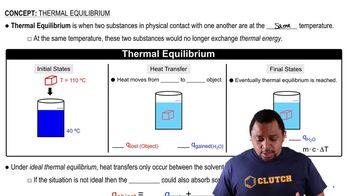The equilibrium 2 NO(𝑔) + Cl2(𝑔) ⇌ 2 NOCl(𝑔) is established at 500.0 K. An equilibrium mixture of the three gases has partial pressures of 0.095 atm, 0.171 atm, and 0.28 atm for NO, Cl2, and NOCl, respectively. (b) If the vessel has a volume of 5.00 L, calculate Kc at this temperature.
Ch.15 - Chemical Equilibrium
Chapter 15, Problem 35
A mixture of 0.10 mol of NO, 0.050 mol of H2, and 0.10 mol of H2O is placed in a 1.0-L vessel at 300 K. The following equilibrium is established: 2 NO(g) + 2 H2(g) ⇌ N2(g) + 2 H2O(g). At equilibrium [NO] = 0.062 M. (a) Calculate the equilibrium concentrations of H2, N2, and H2O.
 Verified step by step guidance
Verified step by step guidance1
Identify the initial concentrations of each species in the reaction. Since the volume of the vessel is 1.0 L, the initial concentrations are: [NO] = 0.10 M, [H2] = 0.050 M, and [H2O] = 0.10 M.
Write the balanced chemical equation for the reaction: 2 NO(g) + 2 H2(g) ⇌ N2(g) + 2 H2O(g).
Set up an ICE (Initial, Change, Equilibrium) table to track the changes in concentrations of each species as the system reaches equilibrium. Use 'x' to represent the change in concentration for the reactants and products.
Use the given equilibrium concentration of NO, [NO] = 0.062 M, to determine the change in concentration, 'x'. Since the initial concentration of NO was 0.10 M, the change is 0.10 M - 0.062 M.
Apply the stoichiometry of the balanced equation to find the changes in concentrations of H2, N2, and H2O. Use these changes to calculate their equilibrium concentrations.
Key Concepts
Here are the essential concepts you must grasp in order to answer the question correctly.
Equilibrium Constant Expression
The equilibrium constant expression (K) relates the concentrations of reactants and products at equilibrium for a given reaction. For the reaction 2 NO(g) + 2 H2(g) ⇌ N2(g) + 2 H2O(g), K is calculated using the formula K = [N2][H2O]^2 / [NO]^2[H2]^2. Understanding how to set up and manipulate this expression is crucial for determining the concentrations of all species at equilibrium.
Recommended video:
Guided course

Equilibrium Constant Expressions
Stoichiometry of the Reaction
Stoichiometry involves the quantitative relationships between the reactants and products in a chemical reaction. In this case, the stoichiometric coefficients indicate that 2 moles of NO react with 2 moles of H2 to produce 1 mole of N2 and 2 moles of H2O. This relationship is essential for calculating the changes in concentration as the system reaches equilibrium.
Recommended video:
Guided course

Stoichiometry Concept
Initial and Equilibrium Concentrations
To solve for equilibrium concentrations, one must understand the initial concentrations of the reactants and how they change as the reaction progresses to equilibrium. The initial concentrations are given, and the change in concentration can be represented using 'x' to denote the amount reacted. By applying these changes to the initial concentrations, one can derive the equilibrium concentrations for all species involved.
Recommended video:
Guided course

Thermal Equilibrium
Related Practice
Textbook Question
Textbook Question
Phosphorus trichloride gas and chlorine gas react to form phosphorus pentachloride gas: PCl3(𝑔) + Cl2(𝑔) ⇌ PCl5(𝑔). A 7.5-L gas vessel is charged with a mixture of PCl3(𝑔) and Cl2(𝑔), which is allowed to equilibrate at 450 K. At equilibrium the partial pressures of the three gases are 𝑃PCl3 = 0.124 atm, 𝑃Cl2 = 0.157 atm, and 𝑃PCl5 = 1.30 atm. (a) What is the value of 𝐾𝑝 at this temperature?
Textbook Question
A mixture of 0.2000 mol of CO2, 0.1000 mol of H2, and 0.1600 mol of H2O is placed in a 2.000-L vessel. The following equilibrium is established at 500 K: CO2(g) + H2(g) ⇌ CO(g) + H2O(g) (d) Calculate Kc for the reaction.
1
views
